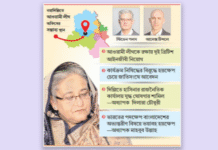Migration remarks: Indian media blasts BJP, praises Bangladesh

Indian analysts also questioned BJP’s reported claim that 4 million illegal Bangladeshi immigrants were now in India
The Indian media has come down heavily on the country’s ruling right wing Hindu nationalist Bharatiya Janata Party (BJP) leader and union minister of state for home affairs, G Kishan Reddy, for his ridiculous comments on Bangladesh on February 9. Reddy had said that “half of the citizens of Bangladesh will leave the country if India offers citizenship to them.”
The Indian analysts also questioned the BJP’s reported claim that 4 million illegal Bangladeshi immigrants were now in India.
The Indian Express and the Hindustan Times in recent weeks have carried comments by eminent Indian scholars suggesting that Indian leaders were wrong in their perception of Bangladesh and must rethink their attitudes to the country, especially with regard to the old mindset that people from this part of the old Bengal found India to be a goldmine for employment or any other benefits.
‘Bangladesh is performing far better’
Karan Thapar, a reputed journalist and television commentator, writes in the Hindustan Times, “Frankly, I blame Henry Kissinger. Way back in the 1970s, he called Bangladesh ‘an international basket case.’”
“At the time, no doubt, it was. Television images of the frequent devastating floods it suffered confirmed this characterisation. So the description stuck. Today, Bangladesh is a different country.”
Thapar had a withering response to Reddy: “Apart from the fact that he was undiplomatic and offensive, Reddy also revealed that he’s ignorant of the true state of Bangladesh. Worse, he doesn’t know that, in comparison to India, Bangladesh is performing far better on many, if not most, of the indices that determine quality of life.”
“So when AK Abdul Momen, Bangladesh’s foreign minister, says, ‘Some Indian nationals are entering Bangladesh illegally for economic reasons,’ he may well be right.”
People migrate to improve their lives, and life in Bangladesh seems decidedly better. If you’re an Indian Muslim in danger of lynching because you trade in meat, accused of love-jihad because you’ve fallen in love with a Hindu, or in fear of losing your citizenship, you could easily be tempted to cross over to the other side.” Thapar’s statement certainly makes sense for a wide swath of people.
‘Our neighbour largely outshines us’
Another analyst, Swati Narayan, a research scholar at the Tata Institute of Social Sciences, wrote in the Indian Express, “Bangladesh’s economic growth rate has surpassed India. In the last decade, on a range of social development indicators, from infant mortality to immunisation, Bangladesh has fared better.”
She also mentioned the recent victory of the Bangladesh Under-19 cricket team against India in the youth World Cup, saying, “Bangladesh beat India at the junior world cup. So why would Bangladeshis en masse want to leave their cherished homeland?”
“Since economic liberalisation, Indians have grown much richer than Bangladeshis, but in terms of quality of life our neighbour largely outshines us,” she wrote.
Swati mentioned her recent doctoral thesis – How have India’s poorer neighbours forged ahead in social development? – where she sought to decode the South Asian development puzzle.
In her opinion, “Bangladesh’s most prominent factor has been its ability to dissolve inequalities through sustained investment in public services and the bridging of social and gender distances.”
“In comparison, India is grappling with the worst unemployment levels in 45 years and sinking economic growth rates.”
Swati writes, “Berating our neighbours with the false bogey of illegal immigrants, in light of the Citizenship Amendment Act (CAA), is nothing but an unjustifiable Islamophobic distraction. Instead, it would be far wiser for the Indian government to humbly learn the recipe of South Asian success to improve the lives of citizens from the impressive “Shonar Bangla” – a term of endearment in reference to Bangladesh.
Immigration from Bangladesh in recent years
India’s national debate on the NRC and CAA shows little sign of drawing to an end. At the core of this debate is the fast-held belief that millions of immigrants from Bangladesh have illegally entered West Bengal, Assam and Tripura, radically altering the demographics of these three states.
A layman’s knowledge about “millions of illegal immigrants” is mostly based on anecdotal evidence and hearsay like “it is known..,” “that vegetable vendor is from…” and “in the border areas…”
Beliefs and opinions, especially when not substantiated by facts, are hard to change.
In West Bengal, if there has been a massive entry of Bangladeshis into the state in recent decades, it should have led to a skyrocketing of the state’s population number and substantially set it apart from the rest of the country.
But, according to census data from 1981, 1991, 2001, and 2011, the growth rate of West Bengal’s population has distinctly been less than the national average since the 1990s. This is true not only for the whole population, but also for both the Hindu and Muslim communities as indicated by the past two or three census figures.
This punctures the myth that West Bengal is bursting with a much larger-than-expected population because of Bangladeshi immigrants.
Both the Indian scholars outline Bangladesh’s achievements at a very appropriate time when the two neighbours have issues to settle over CAA and NRC, but in particular the random border killings which have only to an increase in anti-Indian sentiments in Bangladesh.
To end, a quote from Thapar’s piece says it all: “Life in Bangladesh appears a lot more attractive than in India.”









